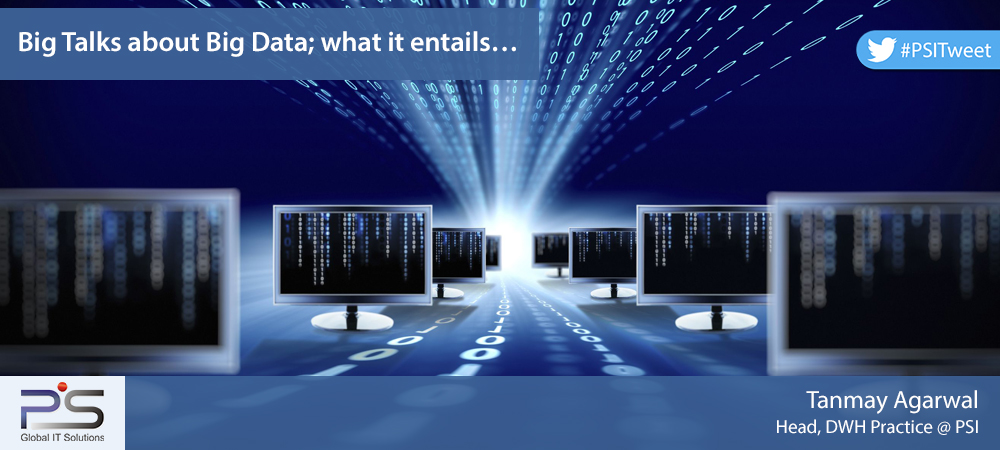
We are talking about massive and gigantic Big data out here. It could be related to any aspect of our lives, however it’s bound to make a difference for us.
For instance, massive data is generated across stores and nations with respect to customer preferences and behavioural patterns. The data about the items purchased, purchasing frequency, amount of money spent, the sizes and much more. How do the companies manage this kind of exhaustive data? How do they use it for predicting customer choices, and formulate strategies? How it can be broken to analyse and draw inferences? Similarly, there is humongous data generated at traffic signals, by telecom operators and many more zones of routine operations.
Big Data Analytics is going to change our perspective of looking at this kind of data. It will enable organizations and institutions to analyse a mix of structured, semi-structured and unstructured data to derive meaningful inferences and data points.
Netflix, an American provider of on-demand Internet streaming offers its users on-demand videos of their favourite TV shows and movies. The company uses Big Data Analytics to understand the viewership success rate of any forthcoming show. They collect data not only about their preferences, but also about the viewer’s behavioural patterns. They analyse the manner in which programs are viewed, viewer base of entire video, breaks or pauses in between and the duration, how often people search for the shows online and their views as mentioned on social media etc. So, the main focus is not just on collecting data, but also to predict what will the users watch.
Big Data entails enormous amount of data from which information can be mined. It basically refers to the remarkable speed of generating new data and ability to store, process and analyse this data. Data is generated by every activity around us all the time. Digital systems, sensors and devices all almost everything transmit data. Big Data translates this to create information for desired outcomes.
There is a lot spoken about the 5 Vs of Big Data: Velocity, Volume, Variety, Veracity and most importantly Value. These five characteristics provide real insights on big data.
The big 5 Vs that define big data are:
- Velocity: The enormous speed with which data is generated and transmitted around. The speed at which information gets viral on social media, the instant money transfers across locations, ecommerce transactions, and online reservations in travel and tourism industry is gathering momentum. Big Data technology helps to analyse this ever increasing and changing data.
- Volume: The vast amount of data is generated every minute. For instance, on Twitter about 6000 tweets are sent every second, and around 50 million in a year. This gigantic data is too large to store and analyse with the traditional database technologies.
- Variety: The data is highly unstructured and varied, which cannot be categorised into tables and other databases easily. The big data solutions connect the different data formats and synchronises them with the traditional structured data.
- Veracity: The authenticity and credibility of the data is under lens. Big data technology allows working with such diverse data.
- Value: The high speed enormous varied and quality data should be translated to value for use. Big Data solutions deliver value in all areas of business and society.
Big Data solutions enable businesses to make more informed choices and business decisions. Exploiting all the available data to provide business insights is a prerequisite for existence. Big data helps organisations to get a comprehensive 360° overview of their business processes.We are talking about massive and gigantic Big data out here. It could be related to any aspect of our lives, however it’s bound to make a difference for us.
For instance, massive data is generated across stores and nations with respect to customer preferences and behavioural patterns. The data about the items purchased, purchasing frequency, amount of money spent, the sizes and much more. How do the companies manage this kind of exhaustive data? How do they use it for predicting customer choices, and formulate strategies? How it can be broken to analyse and draw inferences? Similarly, there is humongous data generated at traffic signals, by telecom operators and many more zones of routine operations.
Big Data Analytics is going to change our perspective of looking at this kind of data. It will enable organizations and institutions to analyse a mix of structured, semi-structured and unstructured data to derive meaningful inferences and data points.
Netflix, an American provider of on-demand Internet streaming offers its users on-demand videos of their favourite TV shows and movies. The company uses Big Data Analytics to understand the viewership success rate of any forthcoming show. They collect data not only about their preferences, but also about the viewer’s behavioural patterns. They analyse the manner in which programs are viewed, viewer base of entire video, breaks or pauses in between and the duration, how often people search for the shows online and their views as mentioned on social media etc. So, the main focus is not just on collecting data, but also to predict what will the users watch.
Big Data entails enormous amount of data from which information can be mined. It basically refers to the remarkable speed of generating new data and ability to store, process and analyse this data. Data is generated by every activity around us all the time. Digital systems, sensors and devices all almost everything transmit data. Big Data translates this to create information for desired outcomes.
There is a lot spoken about the 5 Vs of Big Data: Velocity, Volume, Variety, Veracity and most importantly Value. These five characteristics provide real insights on big data.
The big 5 Vs that define big data are:
- Velocity: The enormous speed with which data is generated and transmitted around. The speed at which information gets viral on social media, the instant money transfers across locations, ecommerce transactions, and online reservations in travel and tourism industry is gathering momentum. Big Data technology helps to analyse this ever increasing and changing data.
- Volume: The vast amount of data is generated every minute. For instance, on Twitter about 6000 tweets are sent every second, and around 50 million in a year. This gigantic data is too large to store and analyse with the traditional database technologies.
- Variety: The data is highly unstructured and varied, which cannot be categorised into tables and other databases easily. The big data solutions connect the different data formats and synchronises them with the traditional structured data.
- Veracity: The authenticity and credibility of the data is under lens. Big data technology allows working with such diverse data.
- Value: The high speed enormous varied and quality data should be translated to value for use. Big Data solutions deliver value in all areas of business and society.
Big Data solutions enable businesses to make more informed choices and business decisions. Exploiting all the available data to provide business insights is a prerequisite for existence. Big data helps organisations to get a comprehensive 360° overview of their business processes.
Tanmay Agarwal is a Consultant & Data Warehouse Practice Head @ PSI[:]








